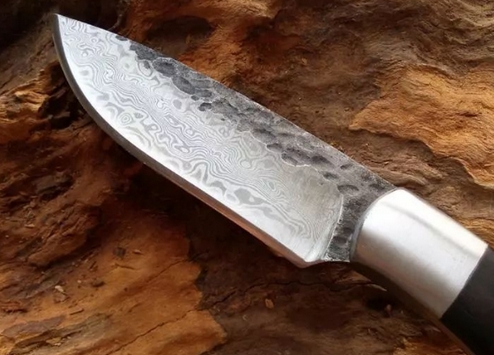Is patterned steel the best for making weapons? Is the patterned steel sold in the market fake? Is real patterned steel the same as Damascus steel? Has it been lost to time? First, we need to understand what patterned steel really is!

Patterned steel, also known as "pattern steel," is a type of steel with patterns used to make valuable items like treasured swords and knives. In ancient China, it was also known as "flowered iron" or "patterned iron." The "Damascus steel" referred to by Europeans, the "Bulat steel" mentioned by Russians, and the steel known as "Pien iron" introduced to China from Persia and Kashmir (known as Jìbīn in ancient times) all belong to the category of patterned steel. Based on the principle of craftsmanship, patterned steel can be divided into cast crystallized patterned steel (Wus steel, Pien iron) and manually forged (welded) patterned steel.
In ancient India, there was a type of high carbon content, which was an excellent material for making knives. Artisans would heat and melt this Wus ore together with various additives. After cooling, it would form a mass of metal, known as Wus steel. Wus steel is a type of natural crystallized patterned steel, which acquires its patterns due to its special composition (impurities mixed with the steel) after casting. These Wus steel ingots were sold to the Damascus region, where local bladesmiths crafted them into weapons. Thus, the "Damascus knife," known for its sharpness, durability, and beauty, gradually earned the reputation of the number one blade.
The natural crystallized patterned steel, after casting, has a structure supported by components of varying hardness, forming a saw-tooth pattern that is only visible under magnification. This saw-tooth pattern makes cutting easier, allowing the blade to move smoothly when slicing and drawing, greatly enhancing the sharpness of the sword.
At the same time, the patterns on the sword are formed by the contrast in color between these different materials. The ancients described them as beautifully starry as the night sky. As time went on, people demanded more from the performance of weapons, and Damascus steel evolved from cast crystallized Damascus steel to manually forged Damascus steel. In China, this transition occurred even earlier, as the natural conditions for producing Wus steel were not available. As early as 2,400 years ago, Chinese artisans began to forge patterned blades using bronze.
Among the various ancient Chinese records of patterned blades (swords), the description in Shen Kuo's "Dream Pool Essays," Volume 19, is considered the most vivid and specific. He mentions "ancient swords like Zhan Lu and Yu Chang; Zhan Lu for its deep, dark black color... Yu Chang is what we now call patterned steel swords, also known as Song Wen: it takes its name from the intestines of cooked fish, which, when observed, resemble the patterns of today's coiled steel sword." According to Shen Kuo, the patterns of the Song Dynasty's coiled steel swords were like the coiled intestines of a fish or the grain of polished pine wood.
Yu Chang sword pattern
The cast Wus steel (Damascus steel) was gradually replaced by forged Damascus steel due to performance issues. The notion of it being "lost" is mere fiction.





 Customer service 1
Customer service 1  Customer service 2
Customer service 2